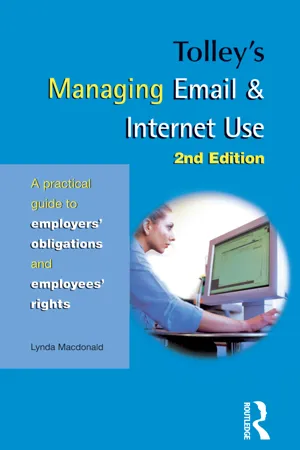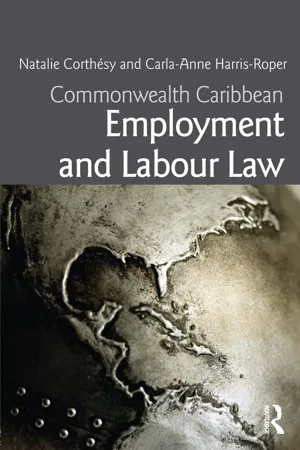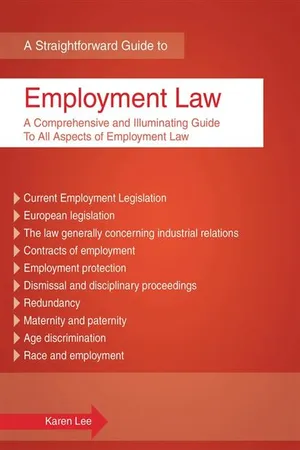Contract of Employment
A contract of employment is a legally binding agreement between an employer and an employee that outlines the terms and conditions of the working relationship. It typically includes details such as job responsibilities, working hours, salary, benefits, and termination procedures. This document serves to protect the rights and obligations of both parties involved in the employment arrangement.
8 Key excerpts on "Contract of Employment"
- eBook - ePub
- Lynda Macdonald(Author)
- 2009(Publication Date)
- Routledge(Publisher)
...5 The Employment Contract Introduction [5.1] A Contract of Employment forms the basis of the relationship between the employer and the employee. All the terms and conditions, rules, obligations and entitlements related to the employee’s employment will be established by reference to the contract. The law does not require a Contract of Employment to be in writing, although employers are under a statutory obligation to issue written particulars of the key terms and conditions of employment to every employee (including part–time employees) within two months of the employee starting work. These written particulars must include (amongst other things) start date, job title, rate of pay, normal hours of work, entitlement to sick pay and holidays, pension entitlements (if any), place of work and notice periods. Additionally, employers who have 20 or more employees must provide written details of any disciplinary rules that exist. Fuller details are given below in 5.19. A Contract of Employment comes into force as soon as there has been an offer of employment and an unconditional acceptance of that offer. This will be the case irrespective of whether all the specific terms of the contract have been agreed at that point in time, and irrespective of whether the offer and the acceptance were in writing or reached as a result of verbal agreement. Once the terms of a Contract of Employment are agreed, they are legally binding on both parties. This means that none of the terms of the contract can be changed without the agreement of the other party. The Inter–Relationship Between Contracts of Employment and Statutory Obligations [5.2] Employee rights that have been created by the passing of legislation are automatically incorporated into every Contract of Employment. It is not open to employers to attempt to exclude an employee’s statutory rights...
- eBook - ePub
- Chris Turner(Author)
- 2013(Publication Date)
- Routledge(Publisher)
...5 The Contract of Employment Aims and Objectives After reading this chapter you should be able to: ■ Understand the basic contractual requirements for a Contract of Employment to exist ■ Understand the scope and significance of the statutory statement under section 1 Employment Rights Act 1996 ■ Understand the ways in which express terms are incorporated into the contract and their significance ■ Understand how collective agreements become part of the Contract of Employment and their significance ■ Understand the significance of works rules to the contract and of the job description ■ Understand the rules regarding variation of terms in employment contracts ■ Critically analyse the law on the Contract of Employment ■ Apply the law to factual situations and reach conclusions 5.1 Formation of the employment contract 5.1.1 The form of the Contract of Employment Although much of employment law is statutory it is also said to be based on the law of contract, and almost all working relationships are governed by contracts. The law of contract generally presumes that the parties have equal bargaining power. However, the employment relationship in reality is very unequal and in general an employee has no choice but than to accept employment on whatever terms the employer dictates, unless the person has a particular skill that is highly in demand. Therefore, the organisation has far more bargaining power. Much of employment law was created through legislation (often from membership of the EU) in an attempt to redress (i.e. to compensate for) this imbalance of power. The employment contract conforms to the general rule that writing is not needed to create a valid contract, and contracts of employment can be made orally or by conduct. The main exceptions are contracts for apprenticeships and merchant seamen, who must have individual written agreements...
- eBook - ePub
Employment Law
The Essentials
- David Balaban Lewis, Malcolm Sargeant(Authors)
- 2019(Publication Date)
- CIPD - Kogan Page(Publisher)
...02 Formation of the Contract of Employment (1) The sources of terms Chapter overview This chapter and the next one are concerned with the Contract of Employment and how it comes into existence. We consider the influences that contribute to establishing the contents of the contract. Express terms agreed between the employer and the employee, or the employee’s representatives, normally take precedence over all other terms. There is a statutory requirement for the employer to issue written particulars of employment to new workers at their start date. These particulars are considered in detail here, as is the influence of collective agreements, workforce agreements, works rules, and custom and practice. LEARNING OUTCOMES After studying this chapter you will be able to: understand and explain the importance of the Contract of Employment to the conduct of human resource management advise colleagues about the status and content of written statements of employment terms and participate in their preparation understand the potential impact of statutory and common law implied terms. 2.1 Contracts of employment Apart from those of apprentices and merchant seamen, who can only be employed under written deeds and articles respectively, contracts of employment may be oral or in writing. 1 A Contract of Employment is like any other contract in the sense that it is subject to the general principles of law. In theory this means that the parties are free to negotiate the terms and conditions that suit them so long as they remain within the constraints imposed by statute and the common law. 2 In practice, the majority of the workforce do not negotiate on an individual basis. An important proportion is engaged on such terms and conditions as are laid down in currently operative collective agreements...
- eBook - ePub
Changing Concepts of Contract
Essays in Honour of Ian Macneil
- David Campbell, Linda Mulcahy, Sally Wheeler, David Campbell, Linda Mulcahy, Sally Wheeler(Authors)
- 2017(Publication Date)
- Palgrave Macmillan(Publisher)
...These terms include the implied terms designed to fill in gaps that are based upon the presumed intentions of the parties. In addition, however, the Contract of Employment is likely to be supplemented by other express rules. In the context of employment, an important market convention or custom concerns whether or not a collective agreement reached between an employer and a representative trade union applies to a particular Contract of Employment. A Contract of Employment may be created informally by an oral offer of work but usually these days there is a written contract that sets out the principal terms such as a job description, wages and hours or work. Most employers supplement this agreement with other rules such as staff handbooks or works rules. The rule-book is likely to put flesh on the bare bones of the contract, specifying, for instance, fringe benefits and how adjustments to hours and wages will be made. The rule-book will also include additional material not mentioned in the contract, such as a disciplinary procedure, general responsibilities and explanations of how the organization is supposed to work, lines of management responsibility and how to get things done. If there is a collective agreement, this will provide an additional body of substantive rules and procedures to be followed. Other formal meetings between representatives of the employer and the work-force, such as works councils, may further add to the rules governing the workplace. Beyond these formal documents there will be ‘custom and practice’, which contains the implied agreements on how jobs should be done and how a particular job role is defined...
- eBook - ePub
- James Marson(Author)
- 2014(Publication Date)
- Routledge(Publisher)
...Implied terms impose rights and obligations on the employer and employee. Contracts of employment are based on classic contractual principles such as freedom of contract, and indeed, the parties are free to identify the terms by which they are willing to be bound, and no one can be forced to agree to a contract to which he or she does not agree. However, it is always worth recognising the imbalance of the power relationship between the parties, and it would generally be the employer who decides on which terms the relationship will be based. The individual, save for relatively few powerful workers, will largely be in a ‘take it or leave it’ situation. SOURCES OF TERMS You must appreciate the sources of the Contract of Employment and their contents because many employment disputes will require reference to the agreement that has been made between the parties. The most obvious source would be the actual Contract of Employment provided to the individual by the employer. Within eight weeks of beginning employment, an employee is entitled to a ‘written statement of particulars’ as provided for in ERA 1996 s.1. There are also other written sources that may be used including collective agreements established between the employer and, for example, a recognised trade union. Terms and conditions of employment may be incorporated through an organisational intranet/works’ handbook. Further, it is especially important to recognise the role of implied terms in employment relationships. Judicial action, particularly in the 1970s and 80s, led to the creation/identification of many implied terms. Key Definition: Collective agreement An employer and a trade union may agree to negotiate on terms and conditions at work, which may apply just to the members of the union or may apply to all workers...
- eBook - ePub
- Natalie Corthésy, Carla-Anne Harris-Roper(Authors)
- 2014(Publication Date)
- Routledge(Publisher)
...CHAPTER 3 CONTRACTS OF EMPLOYMENT PARTIES TO THE Contract of Employment An employment relationship is established when an employer and an employee enter into a contract of service. The definitions of ‘employee’ and ‘employer’ and the contractual tenets that define the scope of their relationship must be examined as separate issues. In the Commonwealth Caribbean, the use of legislation to provide appropriate explanations of who is an employee is pervasive. However, much reliance on case law has been necessary to establish whether the individual relationship is one of ‘contract of service’ or ‘contract for services’; the latter being characteristic of a relationship between an employer and an independent contractor, while the former is indicative of the classic employer/employee relationship. We will first examine the statutory provisions in this regard before turning our attention to the common law context, considering how the intersection of the two arenas impacts a determination of employment status. Who is an employee or worker? Statutory provisions defining who is an ‘employee’ or ‘worker’ are not standard throughout the Commonwealth Caribbean or even within each jurisdiction. Rather unhelpfully, both terms are often used interchangeably, purporting to encompass similar persons, with the purpose for which the law was made being the deciding factor in examining how each term is utilized. 1 This is to be contrasted with the position in the UK, where the term ‘employee’ is used to cover persons in the classic employment relationship who are usually the recipient of more beneficial statutory protections such as unfair dismissal and redundancy...
- eBook - ePub
Introduction to Employment Law
Fundamentals for HR and Business Students
- Kathy Daniels(Author)
- 2022(Publication Date)
- CIPD - Kogan Page(Publisher)
...representative or colleague Yes Yes No Be protected under data protection legislation Yes Yes Yes Receive paid time off for antenatal care Yes No No Take Statutory maternity/adoption/ paternity shared parental leave Yes No No Make a request for flexible working Yes No No Receive paid time off for trade union duties Yes No No Have legal protection if making a protected disclosure Yes Yes Possibly Receive protection from health and safety legislation Yes Yes Yes Explore further Do you think that the courts have arrived at a satisfactory solution to the issue of deciding who is an employee? If not, what potential problems do you see with the current situation? What type of test might improve the current situation? 3.2 The Contract of Employment The Contract of Employment describes the basis of the employment relationship. It can be in writing or it can be agreed orally. It is of great importance in the event of any dispute, because the Contract of Employment explains the way in which the employer and employee have agreed to work together. The Contract of Employment is a legal document and employers should therefore take care in determining the content. The terms of the Contract of Employment can be classified as: 1) express terms; 2) implied terms. Express terms are terms that have been discussed and agreed between the employer and employee. They might not be in writing. It must be emphasised that express terms cannot diminish statutory rights. We examine statutory rights in more detail later in this chapter, but in essence they are rights expressed in law. So, for example, the National Minimum Wage (NMW) is determined by statute. Potentially, the employer can offer a wage of a lower level than the NMW and the employee can accept this...
- eBook - ePub
Straightforward Guide To Employment Law
The Comprehensive and Illuminating Guide to All Aspects of Employment Law - Revised Edition
- (Author)
- 2013(Publication Date)
- Straightforward Publishing Digital(Publisher)
...3 Employment Contracts-Terms of contract Significance of the terms of contract In any dispute between an employer and employee, the terms of the contract are of considerable significance in that one party may have a right to take legal action against the other in respect of any breach of contract. Of more importance is the significance of the terms of contract when an action for unfair dismissal is brought. In such a case, although the question of whether one or more parties has broken the contract is of considerable importance, other considerations arise-notably whether the employer acted reasonably in dismissing the employee. Prior to the introduction of the remedy of unfair dismissal, an employer could always terminate the contract provided that he gave proper notice. The employee would have no recourse in law. Sources of the terms of the contract The terms of the Contract of Employment may be derived from a number of sources: minimum statutory standards; express statements of the parties; collective agreements; works rules books; custom; duties of employees; duties of employers. It should be noted that, by virtue of the 1996 Employment Rights Act, an employer is under an obligation to supply his employees with a written statement containing information as to certain terms of the Contract of Employment. Minimum Statutory Standards In effect all those statutory rights and duties which apply to the employer/employee relationship may be said to form part of every Contract of Employment except those to which the statutory provisions do not apply. With very few exceptions it is not possible for parties to contract out of statutory provisions. Minimum terms orders Certain bodies, notably wage councils, are empowered to make orders which take effect as part of individual contracts of employment and are enforceable as such...







